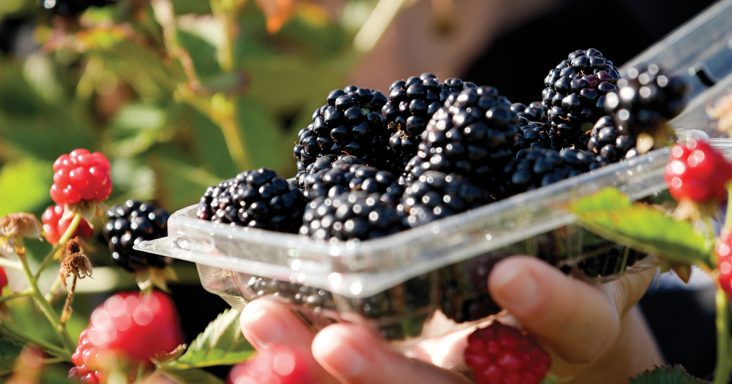Research program brings new blackberry variety to Arkansas
by April 30, 2024 8:22 pm 800 views

Danish farmers were excavating a peat bog in 1835 when they found a woman’s body. It was so well preserved in the bog that initially it was believed she had died there recently. Further examination revealed she had died around 500 BC.
Researchers were stunned when they discovered the Hardaldskaer Woman’s internal organs were intact and she had no signs of any organ disease even though she was estimated to be at least 50 years old, according to Atlas Obscura.
When they examined her stomach, they found she had a diet of millet and blackberries. Her diet is one of the oldest examples of human blackberry consumption recorded.
There is evidence that wild blackberries have been a staple in human diets for thousands of years. The fruit, a member of the rose family and not a berry at all, was indigenous to northern Europe, parts of Asia and the Americas.
Blackberries are primarily grown on the West Coast, but Arkansas grows the second most blackberries among southern states, according to the U.S. Department of Agriculture (USDA). There are an estimated 300 acres in Arkansas dedicated to the crop and its sector value tops more than $4 million annually. There are more than 200 blackberry farms in the state, the USDA reported. The only southern state that grows more acres is Georgia. Oregon is the top blackberry producing state with more than 6,500 acres.
Although blackberries were native to North America, the crop didn’t start to expand until agricultural land clearing led to its expansion across the continent. Around 1825 blackberries began to be cultivated. The number of blackberry acres in Arkansas peaked during the 1950s, when there were an estimated 3,000 acres statewide.
A lot of blackberries are produced in the U.S., but during the late fall and winter the berries are imported primarily from Mexico. The U.S. import market for blackberries was $520 million with nearly 97% of that coming from Mexico, according to ProducePay.
Throughout the years, many varieties of blackberry have been cultivated, and Arkansas is a hotbed for creating new varieties of the fruit bearing plant. The Arkansas Fruit Breeding Program has released a new late-season blackberry to give growers another option after other varieties are done yielding. Commercial scale propagators have licenses and material for sale for the 2024 planting season.
Sweet-Ark Immaculate is a thornless, floricane-fruiting blackberry that offers medium to large berries that have been shown to hold up well after harvest. Floricane varieties produce flowers and fruit on second year canes.
“It is named to highlight its berry quality, which is beyond reproach, and its late-ripening season,” said Margaret Worthington, director of the Fruit Breeding Program for the Arkansas Agricultural Experiment Station. “People have been asking about a new late-season variety from the Arkansas program for a long time now. The main advantages Sweet-Ark Immaculate has over other late-season blackberry varieties are its outstanding post-harvest performance and its great yield potential.”
The experiment station is the research arm of the University of Arkansas System Division of Agriculture.
Worthington said Sweet-Ark Immaculate demonstrates a step forward for blackberry firmness, which aids in holding up well during storage and shipping. Post-harvest trials at the Fruit Research Station near Clarksville show that Sweet-Ark Immaculate had better fruit firmness than all comparison cultivars after two weeks of refrigerated storage.
Maintaining quality in post-harvest storage is especially challenging late in the season, Worthington added, because it is when temperatures are high and spotted wing drosophila pest pressure increases.
Despite its late-ripening window, red drupelet reversion and leak ratings for Sweet-Ark Immaculate were similar to earlier season varieties like Sweet-Ark Caddo and Sweet-Ark Ponca, she said. Red drupelet reversion occurs when the individual round segments on the blackberry turn from black back to red during or after post-harvest storage.
Late-season varieties are treasured for growers in the shipping industry to command a higher premium because less fruit is available during that period. But, she said, it is also nice for local growers who can have fruit available at farmers markets, fruit stands, or pick-your-own operations later in the season.
At the Fruit Research Station, Sweet-Ark Immaculate is typically ready to pick the last week of June through mid-to-late July. Worthington said this period is 10 to 14 days after the harvest of Ouachita but in season with Navaho and Von.
Like Sweet-Ark Ponca, Sweet-Ark Immaculate has shorter-than-standard canes and a reduced space between leaves, also known as the internode length.
“It fills the trellis, but the first-year canes are a little bit shorter than standard,” Worthington said. “This has an advantage for growers because you don’t have to tip during the busy season when harvesting fruit. So, it can spread out the workload a little bit.”
The term “tipping” refers to summer pruning on new blackberry canes performed during the growing season to manage plant height and increase yields by promoting lateral branching.
Including Sweet-Ark Immaculate, the Arkansas Fruit Breeding Program has publicly released 22 blackberry varieties, with 16 of those being floricane fruiting.
